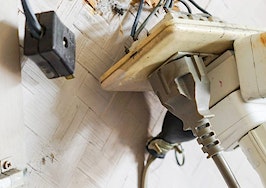It’s a seller’s market right now, and homeowners selling a property that’s been recently updated, upgraded or renovated are well-positioned for a quick, profitable sale.
But what if your client has a fixer-upper and wants to sell as-is? Will the property languish on the market for months? Not to worry — there are definite advantages to listing a property as-is in a seller’s market, and it’s actually a great time to sell a fixer-upper.
What your client needs to know about selling as-is
There could be any number of reasons a client wants to sell as-is, ranging from a job transfer, family emergency or financial burden, to a simple lack of time, resources or energy to do the work required to bring the home up to market value. It’s important you thoroughly assess their situation and understand what’s driving your client’s decision to sell their property as-is.
After you’ve discerned their motivation, your next goal is to manage your client’s expectations, making sure they understand the pros and cons of listing their fixer-upper as is.
In a seller’s market, your client can save money on the front end of an as-is sale if no major repairs or upgrades are being made to the home. Plus, the home could sell quickly because as-is properties often attract investors, flippers or developers who may come bearing a cash offer.
On the other hand, your client might receive less interest and fewer offers precisely because it’s a fixer-upper.
Most importantly, it’s critical your client is comfortable with and understands the essential trade-off: Selling their home as-is ultimately means a lower profit. If they have an unrealistic definition of what “below market” means, be prepared to use all your people skills to finesse their expectations and ensure they’re realistic.
Depending on the condition of the home, you can target about 80 cents on the dollar in a seller’s market, less if the home is in very poor condition or market conditions change.
Cash offers from development franchises or investment firms (“We Buy Ugly Houses,” for example) are often about 65 to 70 percent of a home’s actual value. An individual buyer such as a contractor or a single family looking for a project may be willing to pay a bit more.
Prepping a fixer-upper for sale
When it comes to repairs and upgrades, understand where your client has flexibility and where their boundary lines are drawn. What kind of budget do they have, if any, to make their home market ready?
The key is finding that “sweet spot” of small upgrades and repairs that can boost the home’s value, without over-investing time or money in renovations that aren’t guaranteed to yield a return.
If your client has a budget, consider minor upgrades that are likely to make a home stand out. Minor enhancements might include a fresh coat of interior paint (which can result in a 107 percent ROI), new flooring ($3 to $22 per square foot), or basic landscaping (which can add 5.5 percent to a home’s value).
These updates usually don’t take much time (a few days at most) and can be done for minimum cost.
At the very least, the homeowners should make small repairs wherever possible, whether they DIY them or hire a pro. Create a comprehensive list of easy-to-do projects such as:
- Fix leaky faucets
- Patch holes in the drywall
- Replace outdated light fixtures
- Repair torn screens
- Replace worn out caulk
- Declutter throughout the home
The most important task by far? No matter what condition the home is in, give it a top-to-bottom deep cleaning, preferably by professionals, to put the home in its best light.
Resist thinking the property is a prime candidate for remodeling anyway, so why bother? Give buyers a mental clean slate to work with. Homes that received a deep cleaning before listing saw an almost $2,000 estimated increase in resale value, or a 935 percent ROI.
If there are issues that go beyond the cosmetic that your client has neither the money nor the time to address, it’s a good idea to do a home inspection before you list, which can run from $300-$450. It’s helpful to know what the home’s potential flaws are, from a history of flooding or infestation to structural problems, lead paint, or an HVAC system that’s on its last legs. You’ll avoid deal-breaking surprises down the line.
Yes, you’re obligated to disclose known defects to potential buyers. But disclosing those defects upfront doesn’t obligate the seller to make repairs if you’re clear from the beginning that major repairs are nonnegotiable.
It’s best to be honest and transparent with buyers about the home’s challenges so they can decide if certain defects are deal-breakers and weigh their options accordingly.
Identify your buyer pool
A fixer-upper isn’t the right choice for everyone, but you’re not marketing to everyone. You’re looking for that special buyer who sees potential. That potential may be the opportunity to renovate and flip for profit or to create a customized home, building equity over the long term.
About 1 in 3 millennials say they’d prefer a “fixer-upper” when shopping for a home, and 47 percent say they would be more likely to handle repair and home maintenance jobs themselves. A home that is simply outdated and in need of cosmetic updates like new flooring, appliances, lighting or landscaping may be the perfect property for a family looking to grow into a home they can live in while they update.
For buyers who want to live in a specific area but find the average home prices out of their reach, a fixer-upper with potential is a great way into the neighborhood, a “worst house on the best block” scenario.
Same goes for the buyer frustrated from losing out in bidding wars during a seller’s market. If they’re keen to buy in a coveted location, being willing to renovate or rehab may be the way to go.
Homes in very poor condition that are structurally compromised or have major defects like out-of-date plumbing and electrical are prime targets for contractors or other experienced home flippers looking to turn a profit. Smart flippers know how to maximize their profits and will be looking for the best possible deal. Your client’s home may be a fixer-upper, but they don’t need to accept a lowball offer if you’ve done your homework and your asking price is fair.
Other potential buyers are looking for an opportunity for income with a rental property. A home in need of minimal repairs and upgrades may fit that bill.
Accentuate the positive
Focus on the home’s positives: is it in a highly-desired location or located in a great school district? Close to transportation or walkable to amenities? Highlight the home itself if possible and point out features like original hardwood floors or mature landscaping.
Selling a less-than-perfect home can be daunting. But with a thoughtful strategy and solid plan you’ll find the right buyer who will appreciate the potential, and your client’s home might sell faster than you think.
Ben Mizes is the CEO of Clever Real Estate in St. Louis. Connect with him on Facebook or Twitter.













